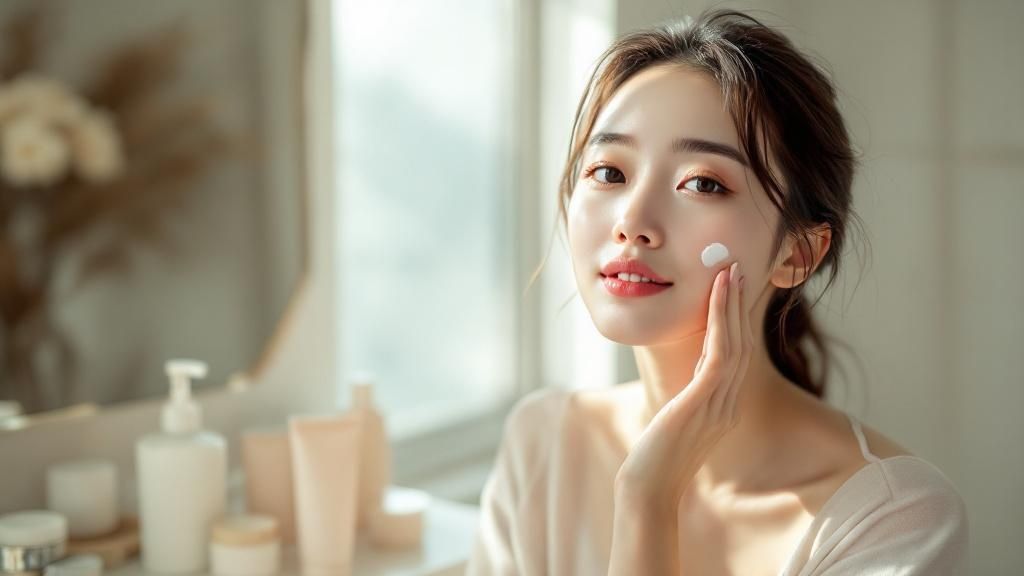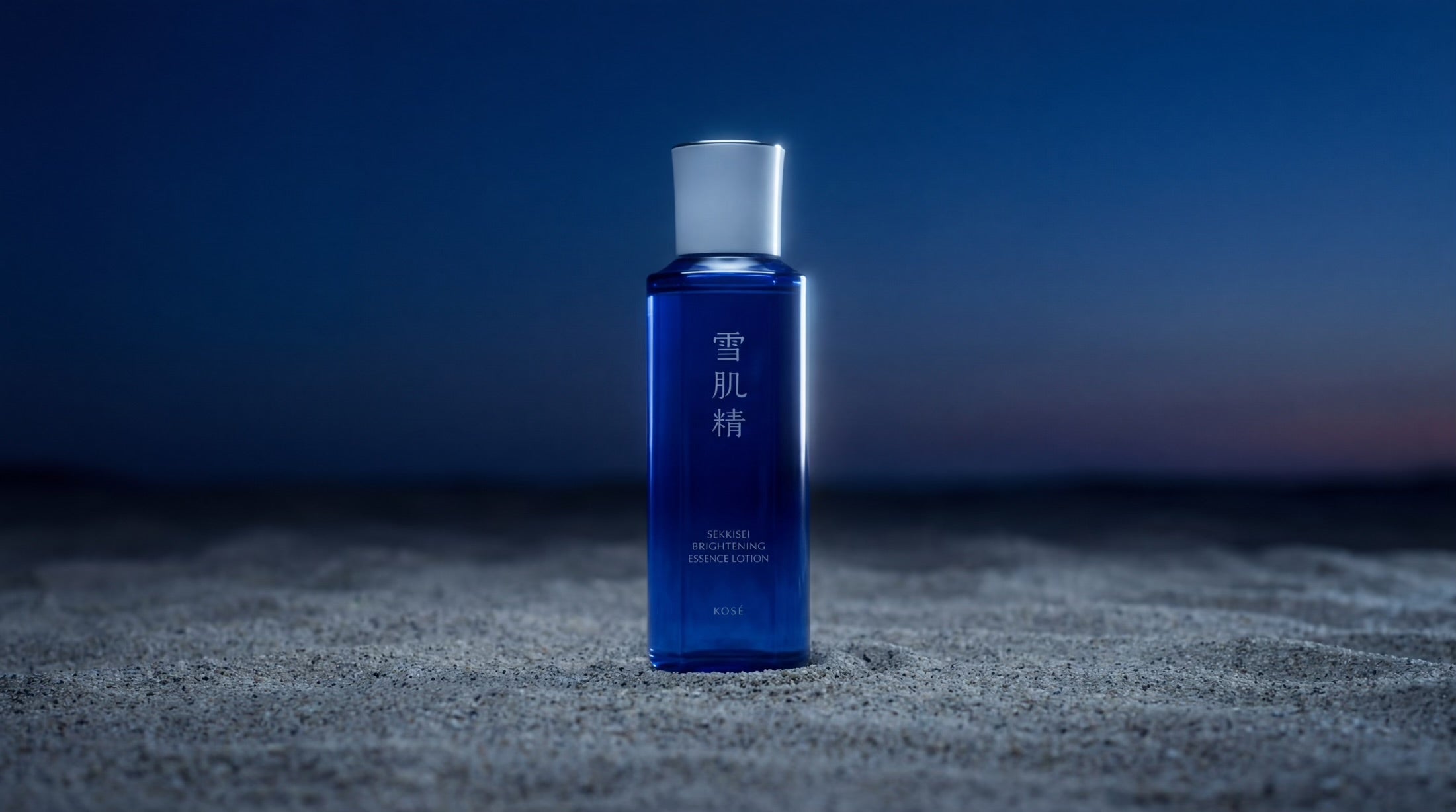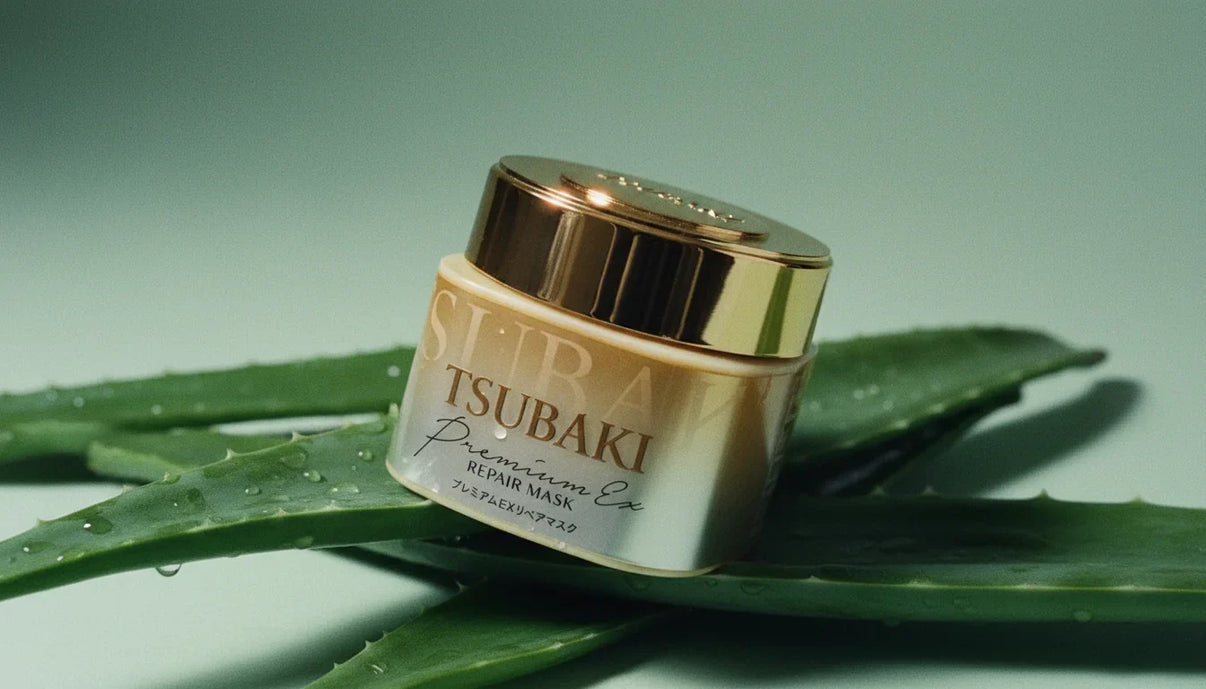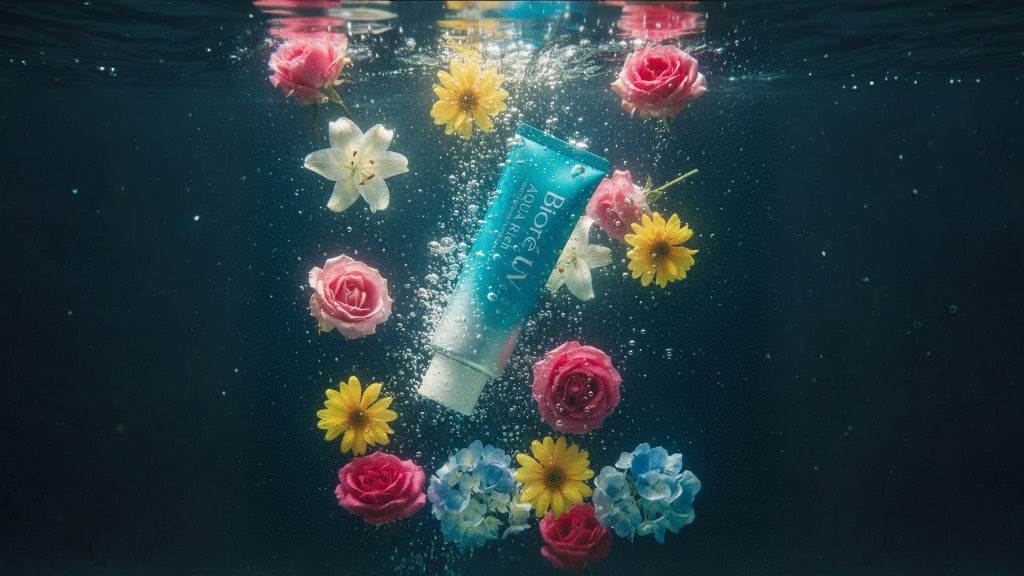Wenn Sie auf der Suche nach dem besten japanischen Gesichtssonnenschutz sind, haben Sie wahrscheinlich Namen wie Biore UV Aqua Rich und Anessa Perfect UV Sunscreen Milk überall gesehen. Das hat einen guten Grund. Sie führen die Charts konsequent an, weil sie einen starken SPF50+-Schutz in unglaublich leichten, serumähnlichen Formeln bieten.
Ehrlich gesagt fühlen sie sich eher wie ein hochwertiger Hautpflegeschritt als wie ein traditioneller, klebriger Sonnenschutz an. Das macht das tägliche Auftragen zu einem Vergnügen, nicht zu einer lästigen Pflicht.
Warum alle über japanische Sonnenschutzmittel sprechen

Also, was ist das große Geheimnis? Warum haben japanische Sonnenschutzmittel eine so massive weltweite Anhängerschaft gewonnen? Es läuft auf ein einziges Konzept hinaus: kosmetische Eleganz.
Im Gegensatz zu den dicken, kreidigen Lotionen, mit denen viele von uns aufgewachsen sind, legen japanische Formeln genauso viel Wert auf das tatsächliche Nutzungserlebnis wie auf den UV-Schutz, den sie bieten.
Dieser nutzerorientierte Ansatz bedeutet, dass sie sich auf der Haut unglaublich anfühlen. Sie ziehen fast sofort ein, hinterlassen keinen geisterhaften weißen Schleier und funktionieren wunderbar unter Make-up, ohne zu verklumpen oder schwer zu wirken. Für so viele Menschen ist das ein echter Wendepunkt, der Sonnenschutz von einer gefürchteten Pflicht in einen nahtlosen Teil ihrer Morgenroutine verwandelt.
Innovation in jeder Flasche
Das Geheimnis ist ihre fortschrittliche Formulierungstechnologie. J-Beauty-Marken haben Zugang zu einer breiteren Palette von UV-Filtern der nächsten Generation, die an Orten wie den Vereinigten Staaten noch nicht zugelassen sind. Diese Freiheit ermöglicht es ihnen, wirklich besondere Produkte zu kreieren.
- Unglaublich leicht: Viele kommen in wässriger Essenz, federleichtem Gel oder milchigen Texturen, die sich anfühlen, als würden Sie überhaupt nichts tragen.
- Ernsthafter Breitbandschutz: Sie werden fast immer einen hohen SPF 50+ in Kombination mit der maximalen PA++++-Bewertung sehen. Diese Kombination schützt Ihre Haut sowohl vor UVB-Strahlen (denen, die verbrennen) als auch vor UVA-Strahlen (denen, die altern lassen).
- Mit Hautpflege angereicherte Formeln: Es ist völlig normal, dass diese Sonnenschutzmittel mit feuchtigkeitsspendenden Inhaltsstoffen wie Hyaluronsäure oder beruhigenden pflanzlichen Extrakten gefüllt sind, was sie zu fleißigen Multitaskern macht.
Diese Besessenheit von überlegenen Formeln zeigt sich deutlich an den Marktzahlen. Während der gesamte Schönheitsmarkt in Japan einen kleinen Rückgang verzeichnete, stieg die Kategorie Sonnenschutz um unglaubliche 13.3% Jahr für Jahr. So sehr schätzen die Menschen diese Produkte.
Diese enorme Nachfrage beweist eigentlich nur einen einfachen Punkt: Wenn ein Produkt nicht nur wirksam, sondern auch eine echte Freude in der Anwendung ist, wird es zu einem unverzichtbaren täglichen Begleiter.
Sie können diese Innovationen selbst erleben, indem Sie einige der bestbewerteten japanischen Sonnenschutzmittel von 2025 ansehen. Das anhaltende Wachstum in diesem Bereich, selbst bei anderen wirtschaftlichen Herausforderungen, ist ein starkes Zeugnis für die unvergleichliche Qualität, die aus dem japanischen Schönheitsmarkt kommt.
SPF- und PA-Bewertungen wie ein Profi entschlüsseln

Im Gang mit den Sonnenschutzmitteln zu stehen, kann sich anfühlen wie das Knacken eines Geheimcodes. Aber wenn du weißt, worauf du achten musst, sind die Etiketten der besten japanischen Gesichtssonnenschutzmittel eigentlich ziemlich klar. Die zwei Bewertungen, die du unbedingt kennen musst, sind LSF und PA. Diese zu verstehen ist der Schlüssel, um den richtigen Schutz auszuwählen.
Zuerst kommt der LSF, oder Lichtschutzfaktor. Denke daran als deinen Schutz gegen UVB-Strahlen – die, die unangenehme Sonnenbrände und sofort sichtbare Hautschäden verursachen. Die Zahl, wie LSF 30 oder 50, sagt dir, wie viel länger du theoretisch in der Sonne bleiben könntest, ohne zu verbrennen, verglichen damit, gar keinen Schutz zu tragen.
Aber der LSF ist nur die halbe Miete. Hier wird das PA-Bewertungssystem zu deinem besten Freund.
Das PA-System verstehen
Die PA-Bewertung, die du mit Pluszeichen (PA+ bis PA++++) sehen wirst, ist ein japanischer Standard, der misst, wie gut ein Sonnenschutzmittel vor UVA-Strahlen schützt. Diese sind die heimtückischen Strahlen. Sie dringen tiefer in die Haut ein und sind die Hauptverursacher vorzeitiger Hautalterung wie feiner Linien und dunkler Flecken.
Hier ist eine kurze Übersicht:
- PA+: Etwas UVA-Schutz.
- PA++: Mäßiger UVA-Schutz.
- PA+++: Guter UVA-Schutz.
- PA++++: Extrem hoher UVA-Schutz.
Du wirst feststellen, dass die meisten erstklassigen japanischen Sonnenschutzmittel stolz eine PA++++-Bewertung tragen. Das ist der Goldstandard und bietet den höchsten Schutz gegen die langfristigen Alterungseffekte der Sonne.
Die wahre Magie liegt darin, ein Produkt zu finden, das in beiden Bereichen überzeugt. Ein hoher LSF schützt dich vor sofortigem Sonnenbrand, während eine hohe PA-Bewertung die langfristige Gesundheit und Jugendlichkeit deiner Haut bewahrt. Dieses Duo ist unverzichtbar für einen vollständigen Sonnenschutz.
Es geht darum, den Schutz an deine Tagespläne anzupassen. Für einen kurzen Arbeitsweg ist ein LSF 30 vielleicht völlig ausreichend. Wenn du jedoch einen Tag im Park oder am Strand planst, solltest du zu einem LSF 50+ PA++++ greifen. Dieser strategische Ansatz schützt deine Haut, ohne dass du das Gefühl hast, eine schwere Maske zu tragen.
Wenn du neugierig bist, wie bestimmte Marken dieses Gleichgewicht meistern, bietet unser Hada Labo Sonnenschutz-Guide großartige Einblicke in die Kunst des japanischen UV-Schutzes.
Das passende Sonnenschutzmittel für deinen Hauttyp finden
Das richtige Sonnenschutzmittel zu finden fühlt sich an wie Dating – es geht darum, die perfekte Übereinstimmung zu finden. Eine Formel, von der eine Person schwärmt, funktioniert vielleicht nicht für dich, und das ist völlig in Ordnung. Das Geheimnis ist, die Etiketten zu lesen und die Textur und Inhaltsstoffe des Sonnenschutzmittels mit dem abzustimmen, was deine Haut wirklich braucht.
Anstatt einfach die beliebteste Flasche aus dem Regal zu greifen, nehmen Sie sich einen Moment Zeit, um über die täglichen Gewohnheiten Ihrer Haut nachzudenken. Wird sie bis zum Mittag glänzend? Oder fühlt sie sich nach dem Waschen gespannt und durstig an? Diese einfachen Fragen zu beantworten, ist der erste Schritt, um Ihren heiligen Gral unter den japanischen Gesichtssonnenschutzmitteln zu finden.
Für fettige und zu Akne neigende Haut
Wenn Ihre Haut überschüssiges Öl produziert oder zu Unreinheiten neigt, ist das Ziel einfach: Finden Sie eine Formel, die Ihnen starken Schutz bietet, ohne Schwere hinzuzufügen oder Ihre Poren zu verstopfen. Sie brauchen etwas, das sich federleicht anfühlt und den Glanz den ganzen Tag über unter Kontrolle hält.
Suchen Sie nach Texturen, die als Gel, Essenzen oder Milch beschrieben werden. Diese sind fast immer wasserbasiert und ziehen innerhalb von Sekunden ein, hinterlassen ein weiches, natürliches oder sogar mattes Finish. Einige wichtige Inhaltsstoffe, auf die Sie achten sollten, sind:
- Zink PCA: Dieser kleine Held hilft, die Talgproduktion zu regulieren und hält den Glanz am Mittag in Schach.
- Silica: Oft in mattierenden Formeln enthalten, wirkt Silica wie ein Schwamm, der überschüssiges Öl auf der Hautoberfläche aufnimmt.
- Alkohol (in Maßen): Obwohl es ein umstrittener Inhaltsstoff sein kann, hilft der kosmetische Alkohol in vielen japanischen Sonnenschutzmitteln, dass sie so schnell trocknen und Ihnen dieses leichte, nicht fettende Gefühl verleihen, das alle lieben.
Für trockene oder dehydrierte Haut
Für trockene oder dehydrierte Haut muss ein Sonnenschutz mehr tun als nur schützen – er sollte auch ein Teamplayer in Ihrer Feuchtigkeitspflege sein. Die falsche Formel kann an trockenen Stellen haften bleiben und Ihre Haut gespannt und unangenehm fühlen lassen. Ihr idealer Begleiter fühlt sich von dem Moment an nährend an, in dem er Ihre Haut berührt.
Sie sollten nach reichhaltigeren Cremes, Lotionen oder milchigen Essenzen suchen. Diese Texturen bieten eine angenehme Feuchtigkeitsschicht, die oft auch als Tagesfeuchtigkeitscreme oder glatte Make-up-Basis dienen kann. Achten Sie auf diese feuchtigkeitsspendenden Stars:
- Hyaluronsäure: Ein bekannter Feuchthaltefaktor, der Feuchtigkeit in die Haut zieht und sie prall und hydratisiert erscheinen lässt.
- Ceramide: Diese Lipide sind essentiell für eine gesunde Hautbarriere. Sie helfen, Feuchtigkeit einzuschließen und Ihre Haut vor Umwelteinflüssen zu schützen.
- Glycerin: Ein weiterer klassischer Feuchthaltefaktor, der Ihrer Haut hilft, ihre natürliche Feuchtigkeit zu bewahren.
Es ist keine Überraschung, dass japanische Sonnenschutzmittel weltweit so gefragt sind. Sie kombinieren meisterhaft leistungsstarken UV-Schutz – oft mit SPF50+ und PA++++ Bewertungen – mit solchen durchdachten, hautfreundlichen Inhaltsstoffen. Diese einzigartige Mischung macht sie kraftvoll und dennoch sanft genug für den täglichen Gebrauch.
Für empfindliche Haut
Wenn Ihre Haut leicht gereizt wird, kann das Ausprobieren eines neuen Produkts sich anfühlen, als würde man auf Eierschalen gehen. Der Schlüssel ist, nach sanften, minimalistischen Formeln zu suchen, die schützen, ohne Rötungen, Brennen oder Unbehagen zu verursachen. Mineralische Sonnenschutzmittel sind in der Regel eine sichere Wahl.
Für empfindliche Haut sind duftfreie und alkoholfreie Formeln unverzichtbar. Mineralische Filter wie Zinkoxid und Titandioxid sind ebenfalls deine besten Freunde. Sie werden in der Regel viel besser vertragen als chemische Filter, da sie auf der Hautoberfläche sitzen und eine physikalische Barriere bilden, anstatt absorbiert zu werden. Dies minimiert das Risiko einer Reaktion erheblich.
Um tiefer in sanfte Formeln einzutauchen, sieh dir unseren vollständigen Leitfaden zu den besten japanischen Sonnenschutzmitteln für empfindliche Haut an.
Japanischer Sonnenschutzfinder nach Hauttyp
Fühlst du dich noch etwas verloren? Kein Problem. Nutze diesen Schnellführer, um deinen Hauttyp mit der idealen Sonnencreme-Textur und den Hauptwirkstoffen abzugleichen, die du oft in japanischen Formulierungen findest.
| Hauttyp | Ideale Textur | Wichtige Inhaltsstoffe, auf die Sie achten sollten | Am besten für A |
|---|---|---|---|
| Ölig / Akne-anfällig | Gel, Essenz, Milch | Zink PCA, Silica, Niacinamid | Mattes, nicht fettendes Finish |
| Trocken / dehydriert | Creme, Lotion, milchige Essenz | Hyaluronsäure, Ceramide, Glycerin | Feuchtigkeitsspendend, taufrisches Finish |
| Empfindlich | Creme, Milch (duftfrei) | Zinkoxid, Titandioxid, Centella Asiatica | Sanfte, nicht reizende Formel |
| Kombination | Essenz, Gel-Creme | Hyaluronsäure, Grüner Tee Extrakt | Ausgewogenes, leichtes Gefühl |
| Reif | Creme, Serum | Kollagen, Peptide, Gelée Royale Extrakt | Straffender, feuchtigkeitsspendender Schutz |
Betrachten Sie diese Tabelle als Ihre Spickzettel. Sobald Sie wissen, worauf Sie achten müssen, wird die Navigation durch die Welt der J-Beauty-Sonnenschutzmittel viel einfacher – und macht viel mehr Spaß.
Wahl Ihrer idealen Sonnenschutztextur und Finish

Sicher, UV-Bewertungen sind wichtig, aber seien wir ehrlich – der wahre Test für einen täglichen Sonnenschutz ist, wie er sich auf Ihrer Haut anfühlt und aussieht. Genau hier glänzen japanische Formeln, die eine ganze Palette von Texturen zur Auswahl bieten. Ihren heiligen Gral unter den J-Beauty-Sonnenschutzmitteln zu finden bedeutet, einen zu wählen, der sich wie ein natürlicher Teil Ihrer Hautpflegeroutine anfühlt und nicht wie eine dicke, klebrige Pflicht am Ende.
Betrachten Sie es so: Die von Ihnen gewählte Textur beeinflusst direkt Ihr Endergebnis. Streben Sie diesen strahlenden, glasartigen Hautglanz an oder bevorzugen Sie einen weichen, glänzfreien Teint? Die richtige Formel bringt Sie dorthin und bietet gleichzeitig unglaublichen Schutz.
Wässrige Essenzen und erfrischende Gele
Wenn Sie schon etwas über J-Beauty-Sonnenschutz gehört haben, dann über Essenzen und Gele. Diese sind die Stars, berühmt für ihr unglaublich leichtes, wässriges Gefühl. Sie ziehen fast sofort in die Haut ein und hinterlassen keinerlei fettigen Rückstand oder weißen Schleier.
- Am besten für: Fettige, Mischhaut und zu Akne neigende Haut werden diese lieben. Sie sind auch ein Traum für alle, die das Gefühl von traditionellem Sonnenschutz wirklich hassen.
- Das Finish: Sie können ein natürliches bis soft-mattes Finish erwarten. Sie sind perfekt unter Make-up, da sie eine glatte Basis schaffen, die nicht verklumpt, und sie helfen sogar, den Glanz tagsüber in Schach zu halten. Die legendäre Biore UV Aqua Rich Watery Essence ist hier das klassische Beispiel.
Nährende Milch und Cremes
Für Haut, die eher trocken ist und sich etwas mehr Feuchtigkeit wünscht, sind milchige und cremige Texturen eine fantastische Wahl. Sie fühlen sich etwas pflegender an als Gele, sind aber im Vergleich zu den meisten westlichen Formeln dennoch unglaublich elegant und leicht.
Sie werden feststellen, dass diese sich oft wie eine schöne Mischung aus einem feuchtigkeitsspendenden Serum und einer leichten Feuchtigkeitscreme anfühlen.
Die Textur eines Sonnenschutzmittels geht nicht nur um Komfort; sie ist der Schlüssel zur konsequenten, täglichen Anwendung. Wenn Ihnen ein Produkt tatsächlich gefällt, wie es sich anfühlt, sind Sie viel eher geneigt, es richtig und regelmäßig aufzutragen. Das ist das wahre Geheimnis wirksamen Sonnenschutzes.
Milch und Cremes können leicht als feuchtigkeitsspendende Grundierung dienen, feine Linien glätten und Ihrer Haut ein pralles, taufrisches Aussehen verleihen. Das ikonische Shiseido Anessa Perfect UV Sunscreen Milk ist ein perfektes Beispiel und bietet ernsthaften Schutz mit einem seidigen, nährenden Gefühl. Das macht es ideal für alle mit trockener, dehydrierter oder reifer Haut, die ein strahlenderes Finish anstreben.
Es ist diese Hingabe an überlegene Texturen, die Japans Sonnenschutzmarkt wachsen ließ und rund 450 Millionen US-Dollar an Umsatz beiträgt. Wenn Sie neugierig sind, können Sie sehen, wie Japans Markt im Vergleich zu globalen Trends auf market.us abschneidet.
Wie man Sonnenschutz für makellosen Schutz aufträgt

Selbst der beste japanische Gesichtssonnenschutz der Welt nützt Ihnen wenig, wenn er nicht richtig aufgetragen wird. Der volle, langanhaltende Schutz hängt wirklich von zwei einfachen Dingen ab: wie viel Sie verwenden und wann Sie ihn in Ihrer Routine auftragen.
So viele Menschen machen den einfachen Fehler, einfach nicht genug zu verwenden. Um tatsächlich den auf der Flasche versprochenen SPF 50+ PA++++ Schutz zu erhalten, müssen Sie großzügig damit umgehen.
Eine super einfache Methode, die richtige Menge zu messen, ist die „Zwei-Finger-Regel“. Drücken Sie einfach zwei Linien Sonnenschutz entlang Ihres Zeige- und Mittelfingers aus. Das ist die magische Menge, die Sie brauchen, um Gesicht und Hals richtig zu bedecken, ohne eine Stelle ungeschützt zu lassen.
Meistern Sie Ihre Morgenroutine
Um das Beste aus Ihrem Sonnenschutz herauszuholen, muss er unbedingt der letzte Schritt in Ihrer Hautpflegeroutine sein. Lassen Sie Ihre Feuchtigkeitscreme eine Minute einziehen, dann tragen Sie Ihren SPF auf. Denken Sie daran als den Schutzschild, der all Ihre harte Arbeit versiegelt.
Es ist entscheidend, ihn zuletzt aufzutragen, weil er einen ununterbrochenen Film über Ihrer Haut bildet. Wenn Sie Make-up tragen, geben Sie dem Sonnenschutz einfach ein paar Minuten zum Einziehen, bevor Sie mit Ihrem Make-up weitermachen.
Einer der größten Mythen, die ich höre, ist, dass der SPF im Make-up ausreichend ist. Das ist er nicht. Die meisten von uns tragen nicht genug Make-up auf, um auch nur annähernd den beworbenen SPF zu erreichen, wodurch unsere Haut verwundbar bleibt. Verwenden Sie immer, immer zuerst einen speziellen Sonnenschutz.
Es ist auch unglaublich häufig, Stellen wie den Hals, die Ohren und den Haaransatz zu vergessen. Diese Bereiche bekommen genauso viel Sonne ab und sind anfällig für die gleichen Anzeichen von Hautalterung. Machen Sie es sich zur Gewohnheit, Sonnenschutz überall dort aufzutragen, wo die Sonne hinkommt. Und während der Gesichtssonnenschutz unser Fokus ist, vergessen Sie nicht Ihre Augen – ein großartiges Paar der besten Sonnenbrillen zum Augenschutz ist unverzichtbar.
Und vergessen Sie nicht, nachzulegen! Wenn Sie draußen sind, schwitzen oder schwimmen, brauchen Sie alle zwei Stunden eine neue Schicht. Für einen normalen Tag im Büro ist es eine großartige Gewohnheit, vor dem Mittagessen nachzulegen. Wenn Sie neugierig auf verschiedene Formeln sind, können Sie mehr über Optionen wie Hada Labo Sonnenschutz für japanischen Sonnenschutz erfahren.
Ihre Fragen zum japanischen Sonnenschutz beantwortet
In die Welt der J-Beauty einzutauchen ist aufregend, aber es ist ganz natürlich, ein paar Fragen zu haben, besonders wenn man etwas so Wichtiges wie den täglichen Sonnenschutz auswählt. Die richtigen Antworten zu bekommen, macht den entscheidenden Unterschied, um eine solide Gewohnheit im Sonnenschutz aufzubauen. Lassen Sie uns einige der häufigsten Fragen klären, die Menschen haben.
Zuerst: Können Sie diese schicke neue Gesichtssonnencreme an Armen und Beinen verwenden? Die kurze Antwort lautet ja, absolut! Jede Formel, die sanft genug für Ihr Gesicht ist, funktioniert auch perfekt am Körper.
Der einzige wirkliche Nachteil ist der Preis. Gesichtssonnencremes kommen typischerweise in kleineren Tuben, sodass Sie sie schnell aufbrauchen würden. Wenn Sie dieses elegante, leichte Gefühl für den Ganzkörperschutz haben möchten, ohne das Budget zu sprengen, ist es am besten, sich einige der Top-Auswahlen japanischer Körpersonnencremes für 2025 anzusehen. Sie bieten schöne Texturen in viel größeren, praktischeren Größen.
Wie man japanische Sonnencreme richtig entfernt
Das ist ein wichtiger Punkt. Müssen Sie sich wirklich jede Nacht doppelt reinigen? Wenn Sie eine Formel verwenden, die wasserfest, schweißresistent oder talgresistent ist, lautet die Antwort ein klares Ja. Diese Sonnencremes sind langlebig, was bedeutet, dass eine einzige Reinigung mit Ihrem normalen Gesichtsreiniger nicht ausreicht.
Denken Sie so darüber nach: Ein ölbasierter Reiniger wirkt wie ein Magnet für die ölhaltigen Bestandteile Ihrer Sonnencreme und Ihres Make-ups. Er löst alles effektiv auf, sodass Ihr zweiter, wasserbasierter Reiniger alles wegspülen kann, Ihre Poren wirklich reinigt und potenzielle Hautunreinheiten verhindert.
Hinterlässt sie einen weißen Schleier auf meiner Haut?
Der gefürchtete weiße Schleier ist ein großes Problem, besonders für Menschen mit dunkleren Hauttönen. Das ist tatsächlich einer der Hauptgründe, warum japanische Sonnencremes so beliebt wurden – die überwiegende Mehrheit der chemischen und Hybridformeln ist so konzipiert, dass sie völlig transparent sind. Sie ziehen spurlos ein und hinterlassen keinerlei kreidigen oder aschigen Rückstand.
Selbst die rein mineralischen japanischen Optionen verwenden weitaus fortschrittlichere Technologien als das, was Sie vielleicht gewohnt sind. Dieser intensive Fokus auf "kosmetische Eleganz" sorgt dafür, dass sie sich nahtlos in eine große Bandbreite von Hauttönen einfügen.
Wo man authentische Produkte findet
Schließlich müssen Sie wissen, wo Sie einkaufen, um Fälschungen zu vermeiden. Um sicherzugehen, dass Sie das Original erhalten, kaufen Sie immer bei Händlern, die sich auf asiatische Schönheit spezialisiert haben und einen vertrauenswürdigen Ruf genießen.
- Vertrauenswürdige Online-Shops: Websites wie Stylevana, YesStyle und Olive Young Global sind beliebte, zuverlässige Quellen für authentische J-Beauty.
- Seien Sie schlau bei Amazon: Wenn Sie bei Amazon einkaufen, achten Sie genau auf die Verkäuferbewertungen und lesen Sie die Kundenrezensionen sorgfältig, um die Echtheit zu überprüfen, bevor Sie auf "kaufen" klicken.
- Lokale Schönheitsshops: Übersehen Sie nicht die lokalen japanischen oder pan-asiatischen Schönheitsshops in Ihrer Stadt! Sie sind oft wahre Fundgruben für echte Produkte und können fantastische, persönliche Beratung bieten.
Bereit, Ihren perfekten Partner zu finden? Entdecken Sie eine kuratierte Sammlung authentischer, hoch bewerteter japanischer Sonnencremes bei Buy Me Japan. Starten Sie jetzt Ihren Einkauf und erleben Sie den Unterschied selbst!




Compartir:
Den besten japanischen Gesichtsreiniger für Sie finden
Die besten japanischen Haarprodukte für Sie finden